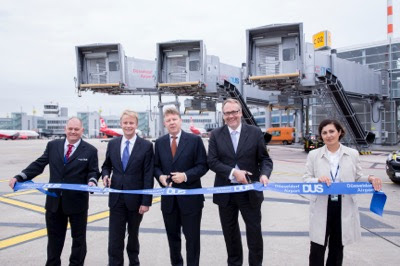 Another milestone is complete in Düsseldorf Airport’s (DUS) preparation for regular A380 service. Construction for the new A380 handling gate and three movable passenger bridges is now complete, and the world’s largest aircraft’s first flight is scheduled for July 1, 2015, by Emirates Airlines between DUS and its Dubai hub. Passengers will then be able to board the 2-story wide-body plane at the new handling gate from three moveable passenger bridges. The new A380 position at Gate C is now official. DUS presented the position to and then opened it with its partner Emirates Airlines. (Photo – Ribbon Cutting at the Opening of the A380 Handling Position. From left to right: Hartmut Antoni (Director of Air Traffic) Volker Greiner (Emirates Vice President North & Central Europe), Dr. Ludger Dohm (Chairman of Düsseldorf Airport’s Management Board), Rolf Ansel (Emirates Airport Services Manager Düsseldorf), and Massoumeh Raissi (Project Director, A380-Handling Position).
Another milestone is complete in Düsseldorf Airport’s (DUS) preparation for regular A380 service. Construction for the new A380 handling gate and three movable passenger bridges is now complete, and the world’s largest aircraft’s first flight is scheduled for July 1, 2015, by Emirates Airlines between DUS and its Dubai hub. Passengers will then be able to board the 2-story wide-body plane at the new handling gate from three moveable passenger bridges. The new A380 position at Gate C is now official. DUS presented the position to and then opened it with its partner Emirates Airlines. (Photo – Ribbon Cutting at the Opening of the A380 Handling Position. From left to right: Hartmut Antoni (Director of Air Traffic) Volker Greiner (Emirates Vice President North & Central Europe), Dr. Ludger Dohm (Chairman of Düsseldorf Airport’s Management Board), Rolf Ansel (Emirates Airport Services Manager Düsseldorf), and Massoumeh Raissi (Project Director, A380-Handling Position).
The chairman of the airport’s management board Dr. Ludger Dohm says, “We are proud and excited to welcome the Airbus A380 at our airport soon. Bringing the Airbus flagship to the people of North-Rhine Westphalia is a huge step in serving their ever-increasing mobility needs. Emirate’s decision illustrates how important the region is for the airline. A thank you to our long-time partner for the trust in us, and we look forward to the maiden flight on July 1. A special thank you also to our project team who have put their energy and heart into making Düsseldorf Airport A380 compatible.”
To be able to handle the giant aircraft, Düsseldorf Airport invested 2.5 years and about 5 million euros into making structural changes. With construction completed, the airport is ready for handling wide-body aircrafts like the Airbus A380.
The changes include a modern two-level connection at Gate C and three moveable passenger bridges (“fingers”) for quick and easy passenger boarding and disembarking. One of these height-adjustable fingers will lead passengers directly to the upper deck inside the Super Airbus. The stationary part of the glass-enclosed bridge is about 22 meters (72 feet) long and 7 meters (23 feet) tall and leads to a staircase with a height of about 11 meters (36 feet). 130 tons of steel went into the construction. The adjacent gate at Terminal C was expanded and now offers 225 seats. New markers were installed at the airport ramp for an A380-compatible taxiway width of 95 meters (312 feet). In addition to structural changes, handling the A380 also requires the use of larger vehicles such as tank trucks, tractors, and de-icing and catering vehicles.
Volker Greiner, Emirates VP North & Central Europe, says, “We are excited about Düsseldorf Airport’s successful completion of A380 preparations and we congratulate them on the new handling position. Since we started flying from Düsseldorf, the destination has consistently been an important strategic destination for Emirates. We are proud to be the first airline to start regular service to North-Rhine Westphalia’s capital on the distinctive A380. The use of airplanes with larger capacities is crucial for us in meeting the growing passenger demand for flights and seamless connections between one of Germany’s strongest economic regions and emerging economies in Asia, Africa, and the Middle East.”
The daily Emirates flight to Dubai on Airbus A380 departs DUS at 3:25 PM with 517 seats in a three-class configuration (First Class with 14 private suits, Business Class with 76 flatbed seats, and Economy with 427 modern seats featuring private screens). On the upper deck, an exclusive on-board-lounge and bar are available for First and Business-class passengers. For its second daily flight to Dubai, which departs at 9:25 PM, Emirates will continue to use a Boing B777-300ER.



